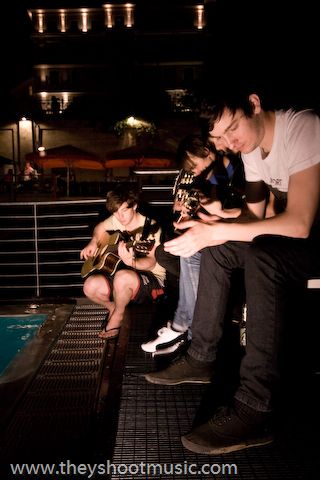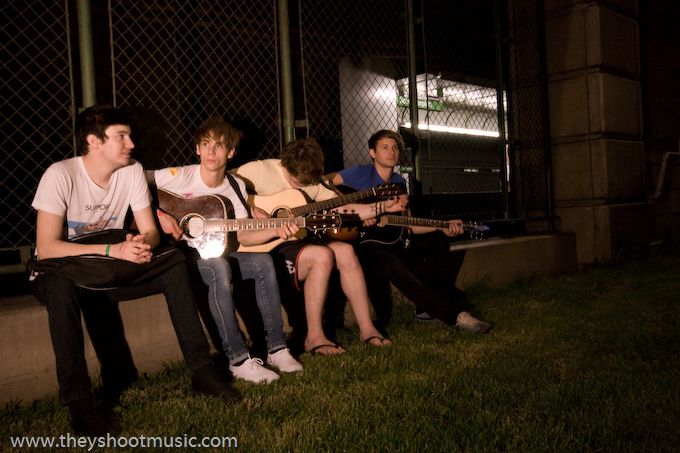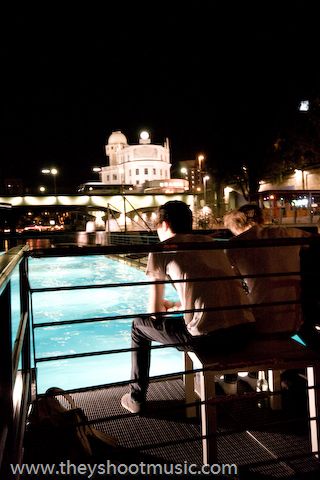Look See Proof
Badeschiff, Donaukanal, 2008
It is just a few days till the release of their debut album “Between Here and There”, when Look See Proof gather at the pool floating on the Danube Canal on a mild Friday evening to play an acoustic version of “Casualty”. The four young Englishman do not get spotted as the hot Newcomer band that will play the basement the same night. While laid-back David Sells (singer and bassist) scuffs out of the venue with his flip-flops in casual shorts and T-shirt – humming some ad-lib lyrics – some stylish crowd enters the ship deck where they are awaiting the Look See Proof performance hosted by an Austrian fashion magazine. Meanwhile David, his brother Lee (vocals and guitar), Jason Slender (guitar) and John Harry (vocals and guitar) take a seat for playing “Standard Class” at a projection on the wall with the underground railway passing behind their backs. The band from Hertfordshire complements its short and sharp guitar riffs with vocal harmonies in a very forceful way. “Casualty” has even been chosen for the soundtrack of the official EURO 2008 computer game. Their catchy melodies not only appeal to the developers of computer games or fashionistas. It is also promenading couples that applaud them for their energetic outdoor session.
- Photography
- Simon Brugner
- Artist
- Look See Proof




Badeschiff
Badeschiff is a floating open air bath anchored in the Donaukanal near bustling Schwedenplatz. It consists of two ships that are tied together with the big one hosting a sun deck, a bar, a restaurant and a music club in the basement fittingly called Laderaum (cargo hold) and the smaller one appending the pool area. Badeschiff is one of four private run open air baths in Vienna and definitely has the longest opening hours of all the city’s bathing facilities. There are still people swimming their laps in the 26-meter-long pool when the nearby banks of the Donaukanal become busy in the evening and the nightlife crowd passes by to get to the numerous bars and cafés of the area. Badeschiff was opened in July 2006 and inspired by a very similar floating swimming pool in Berlin. The idea, though, is not new. Parisians are said to have built an ancestor of today’s Badeschiff in 1761. A Viennese doctor soon improved the French model and opened a so-called bathing raft which served as an archetype for several pool ships all over Europe. Almost 250 years later the 18th century idea got revived and – again – spreads on the continent.
Donaukanal
Donaukanal is the southern side arm of the river Danube in Vienna. Although the 17 kilometres long canal is quite narrow it is far more connected to the city than the actual Danube, passing the Inner City including all the nightlife hotspots around Schwedenplatz as well as the popular recreation area Prater. The vicinity to the city center may as well be the reason that the canal is particularly appealing to joggers, bikers and walkers. In the past two decades local politicians often discussed chances to integrate the Donaukanal even more in the city’s life by supporting the spread of clubs and bars like the old-established Flex or the newly created Badeschiff and making it a reasonable choice to spend your night out enjoying yourself on the concrete banks of the canal. What is now the canal was the main river until medieval times. Repeated floods frequently relocated the riverbed north- or southwards and – together with extensive river training measures – changed the hierarchy. Since around 1700 the side arm is known as Donaukanal.